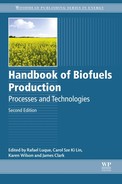15.7. Challenges and opportunities
Biomass gasification is the most effective technology for the conversion of solid biomass into hydrogen, biofuels, and high-value chemicals through the production of bio-syngas. However, it is not a mature technology and the majority of the commercial facilities which are in operation worldwide are dedicated to heat and power generation. Technical challenges need to be addressed in order to ensure cost-effective production of high-quality bio-syngas to meet the demand for downstream conversion into hydrogen and other high-value products.
One of the challenges is related to biomass feedstock selection, consistency, availability, and logistics. Biomass resources are scattered and long-distance transportation is expensive and nonsustainable due to the low energy density of the feedstock. New solutions are being investigated such as selection of biomass which yields larger amount of syngas and H2, pretreatment processes to increase biomass energy density, use of waste as feedstock, and distributed technology.
There is also a lack of large-scale performance indicators. Significant efforts are being made on process intensification and improvement of gasifier design in order to allow cost-effective production of syngas and hydrogen. However, more pilot and demonstration projects are required in order to validate and demonstrate the technology at industrially relevant environments, and to compete with well-established processes at a commercial level, including biomass combustion. Cogasification of biomass in large integrated gasification combined cycles (IGCC) is a short- and mid-term alternative until mature biomass gasification technology is available. This process would reduce the need for dedicated biomass logistics and technologies, while giving improved biomass economies of scale.
A significant number of challenges are related to the improvement of clean-up technologies to obtain a syngas stream with the quality required by downstream conversion processes. The development of more efficient tar removal techniques, both in cold and in hot conditioning routes, will improve the economics of biomass gasification. In addition, further progress is necessary to implement the hot conditioning route for avoiding energy penalties when biomass gasification is coupled with steam reforming both at large scale (for production of bio-hydrogen or other chemicals) and small scale (for application in fuel cells). Engineering aspects like pressure drop or mechanical properties of catalysts of the hot conditioning reactors have been overlooked, since most of the studies have been performed at lab-scale and mainly focused on catalytic performance. Studies on the hot gas conditioning technologies at pilot and demonstration scales are needed. Although lab-scale results are encouraging, the conditions will differ after scaling up and its viability needs to be demonstrated at a higher scale.
Nontechnical challenges also have an important influence on the development of gasification technology. Although the economic and environmental reasons are major drivers for the continuous advance in the development of the technology, politics and governmental decisions are required for achieving deployment of biomass gasification, as well as other renewable energies (Huber et al., 2006; Balat and Kirtay, 2010; Jahirul et al., 2012; Higman and Van der Burgt, 2011; Bridgwater, 2003; Faaij, 2006). This has been recognized in the World Energy Outlook, where the International Energy Agency states that government policies can influence the pace at which these energies can substitute fossil fuels (IEA, 2013).
Lately some governments and policymakers seem to have realized this need and have started taking decisions in this way (Van der Drift and Boerrigter, 2006; Balat and Kirtay, 2010; Faaij, 2006; The President's, 2015; SET, 2015). Two interesting examples of these change of behavior are the Climate Action Plan in the US and the European Strategic Energy Technology Plan of the European Union (The President's, 2015; SET, 2015). Focusing on the EU plan, one of the objectives is to achieve 14% of the European energy mix by 2020 from cost-competitive and sustainable bioenergy, what is expected to create more than 200,000 jobs. With this in mind, 9 billions € are going to be invested by the EU in the coming years in bioenergy projects (SET, 2015). In this sense, gasification will play a key role in the development of a cost-competitive bioenergy sector, due to its highest degree of development and best positioning to be implemented shortly. Projects like BioSNG (http://www.bio-sng.com) and BioProGreSs (http://bioprogress.se/) are good examples of the important bet of the EU in gasification as a key technology in the future energy plans.
Addressing technical and nontechnical challenges is required now in order to develop mature gasification technology, which will allow the deployment of syngas platform biorefining and production of sustainable hydrogen, biofuels, and chemicals from biomass to be a reality.
..................Content has been hidden....................
You can't read the all page of ebook, please click here login for view all page.
